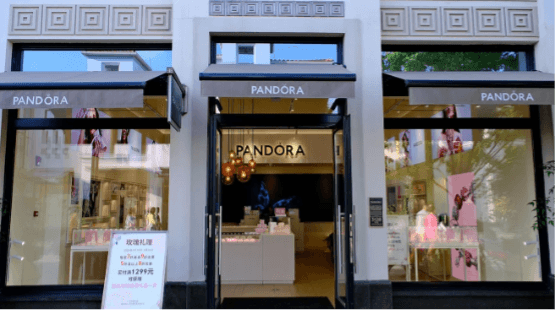
Pandora will close approximately 100 underperforming stores in China to “optimize the store network,” even as overall revenue for the second quarter rose.
The Danish jeweler had previously targeted about 50 stores on the mainland for closure, it said Friday. That means that Pandora will open a net 25 to 50 locations worldwide over the full fiscal year, rather than the 50 to 75 it had previously expected. In total, the company plans to expand its network by 400 to 500 shops by the end of 2026, it explained.
During the second quarter that ended June 30, revenue rose 4% on a reported basis and 8% on an organic basis to DKK 7.08 billion ($1.11 billion). Organic growth reflects sales in local currencies after adjusting for changes to the company’s structure, such as the addition or removal of distributors and franchisees. Sales grew 3% on a like-for-like basis, receiving a boost from strong demand in the US, particularly over the Mother’s Day holiday. Profit grew 0.5% to DKK 803 million ($125.9 million).
During the quarter, the jeweler saw like-for-like growth of 36% for its Pandora Lab-Grown Diamonds collection, the second-highest rise of all its segments. However, the popularity of the lab-grown collection has had a negative effect on the company’s bottom line.
“Product mix contributed negatively driven by the strong performance in Collabs and Pandora Lab-Grown Diamonds, which both carry gross margins below group level,” Pandora said.
Although the company had strong results despite US tariffs, Pandora sees potential issues with products it sources from Thailand, China, Vietnam, India, and other countries. The jeweler has been working on mitigation measures, including switching some of its supply sourcing, as well as shipping jewelry to Canada and Latin America instead of through its US distribution center, it said. Pandora believes it will incur an impact of DKK 200 million ($31.4 million) from tariffs in 2025 and DKK 450 million ($70.6 million) in 2026. The retailer is considering price increases to reduce the impact, it said.
So far, Pandora has seen a rise of around 2% on a like-for-like basis in July, following the close of the second quarter. The timing of sales impacted the growth, particularly the end of season sale, which occurred in May during Mother’s Day and saw customers purchasing earlier in the year. It also depleted stock levels and left the company with less product to sell, Pandora added.
Image: A Pandora store in Shanghai, China. (Shutterstock)
